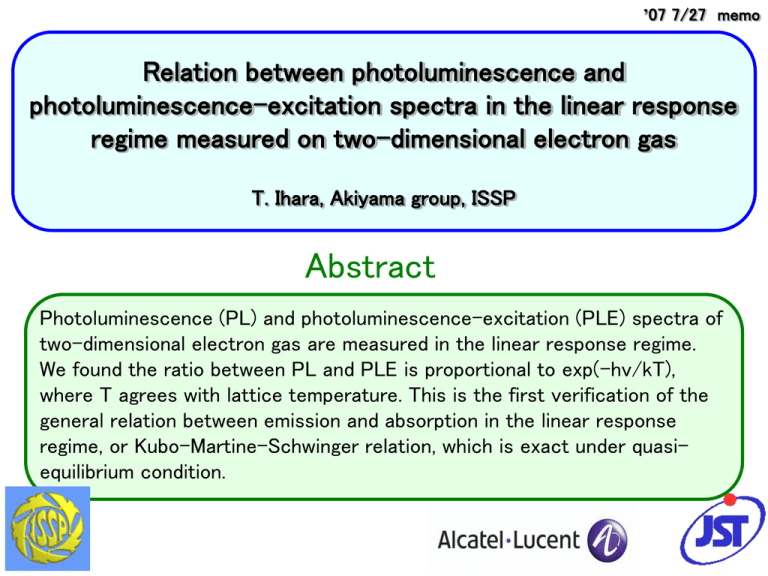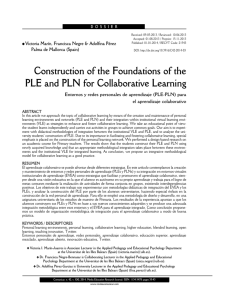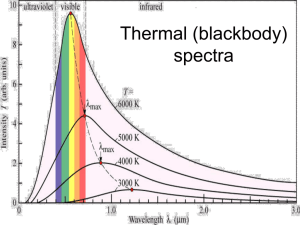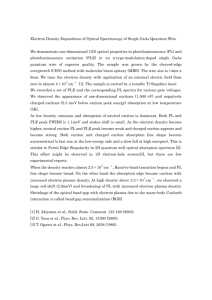PowerPoint プレゼンテーション
advertisement

’07 7/27 memo Relation between photoluminescence and photoluminescence-excitation spectra in the linear response regime measured on two-dimensional electron gas T. Ihara, Akiyama group, ISSP Abstract Photoluminescence (PL) and photoluminescence-excitation (PLE) spectra of two-dimensional electron gas are measured in the linear response regime. We found the ratio between PL and PLE is proportional to exp(-hv/kT), where T agrees with lattice temperature. This is the first verification of the general relation between emission and absorption in the linear response regime, or Kubo-Martine-Schwinger relation, which is exact under quasiequilibrium condition. Introduction In photoluminescence-excitation (PLE) measurements, the intensity of photoluminescence (PL) is recorded as a function of excitation photon energy. Under a condition of fast intra-band relaxation, PLE is equivalent to linear absorption spectra [1, 2]. Using micro-PL technique, we can compare the lineshape of PLE with PL at the same microscopic region of 1mm order. The relation between PL and PLE in the linear response regime is the focus of this paper. [1] Fundamentals of Semiconductors 3rd Edition, Yu-Cardona (2001) “In high quality GaAs QWs, the scattering processes with LO photon and acoustic phonon occur on picosecond and subpicosecond time scales, which are significantly shorter than the radiative lifetime. Thus, one finds a good correspondence between the PLE and absorption spectra.” [2] K. Hannewald et al., Phys. Rev. B 67, 233202 (2003). “The supposed equivalence between PLE and absorption signals in semiconductors relies on the assumption that the recombination times are much larger than the intra-band relaxation times, I.e., if the laser-excited electrons and holes have enough time to relax completely into quasi-equilibrium before radiative recombination.” Introduction According to early theories [3], the relation between emission (I) and absorption (A) of quasiequilibrium systems in semiconductors could be written in a simple form: 1 I A - ① exp m / k B T 1 where hv is photon energy, m is chemical potential, T is temperature. This is known as Kubo-MartineSchwinger relation, which has been investigated experimentally by time-resolved spectroscopy [4]. Under low-excitation power condition, this relation becomes simpler since exponential part becomes larger than 1; - ② I exp / k B T A This relation is same form as Kennerd-Stepanov relation, which has been indicated by D. A. Sawicki et al. [5] as a general relation between emission and absorption of a system in thermal equilibrium. There are two required conditions for these relations; Linear response and Quasi-equilibrium. There have been no experiments that achieved the verification of relation ② under proper conditions. [3] H. Haug et al., Prog. Quantum Electron. 9, 3 (1984). [4] S. Chatterjee, C. Ell, S. Mosor, G. Khitrova, and H. M. Gibbs, W. Hoyer, M. Kira, S. W. Koch, J. P. Prineas, and H. Stolz, Phys. Rev. Lett. 92, 067402 (2004). [5] D. A. Sawicki and R. S. Knox, Phys. Rev. A 54, 4837 (1996). In this letter In this letter, we study the relation between PL and PLE spectra of twodimensional electron gas in the linear response regime. We found the ratio between PL and PLE is proportional to exp(-hv/kT), where T agrees with lattice temperature. This is the first verification of the general relation between emission and absorption in the linear response regime, or Kubo-Martine-Schwinger relation, which is exact under quasi-equilibrium condition. ・ ・ ・ ・ ・ ・ PL independent on Pex -> emission in linear response regime PL independent on Eex -> Fast intraband relaxation. PLE independent on Pex -> absorption in linear response regime PL/PLE = exp(-hv/kT) -> no exception in whole photon energy region T*=TL -> Quasi-Equilibrium at TL T*=TL at any TL -> no exception in temperature ∴ we achieved the verification of I/A = exp(-hv/kT) Optical setup and sample structure PL and PLE measurement in a backscattering geometry. Detect PL polarized with perpendicular to the polarization of excitation laser 2DEG density ( VDP measurement) : 6×1010 cm-2 Power/Energy dependence of PL spectra at 30K Lineshape of PL are independent with excitation power at Pex < 80 mW. -> PL in the linear response regime Lineshape of PL are independent with excitation photon energy at Pex = 1.7 mW. -> fast intra-band relaxation Power dependence of PLE spectra at 30K Lineshape of PL and PLE are independent with excitation power at Pex < 80 mW. -> PLE in the linear response regime Fast relaxation -> PLE is equivalent to linear absorption spectra Ratio of PL and PLE at Pex = 1.7mW (T = 30K) PL/PLE shows exponential decay against hv. No exception in whole photon energy region. Estimated temperature (T* = 30±2 K) agrees with the lattice temperature (TL = 30.8±1K) -> Photo-excited 2DEG is in quasi-equilibrium at lattice temperature. PL/PLE at various temperatures (Pex = 16 mW ) T* agree with TL at various temperature. PL -> verification of general relation between PL and PLE exp in the linear response regime for quasi-equilibrium system : PLE k BT PL with resonant/non-resonant excitation at 5K (Pex = 2 mW) In the case of resonant excitation, T* (= 6.2±0.3 K) agrees with TL (= 5.6±1 K). In the case of non-resonant excitation (+ 6.3 meV), T* (= 7.2±0.5 K) is higher than TL (= 5.6±1 K) and additional non-equilibrium component appears at higher energy side (ML fluctuation). Summary Photoluminescence and photoluminescence-excitation spectra of two-dimensional electron gas are measured at low-excitation power in the linear response regime. We found that the ratio between PL and PLE is proportional to exp(-hv/kT), where T agrees with lattice temperature, even at 6K under resonant-excitation. This is the first verification of the general relation between emission and absorption in the linear response regime, or Kubo-Martine-Schwinger relation, which is exact under quasi-equilibrium condition. 課題 : Discussionをまとめる ・ ・ ・ ・ ・ ・ ・ 共鳴励起・ドーピング・CW励起・高品質QW・顕微分光 などの必要性 Knoxやchatterjee論文中の実験結果へのコメント 温度を求める方法について、温度制限、非平衡の場合 全波長領域で成立することの意味、幅の由来、不均一幅の影響 理論計算でのKMSについて 半導体以外の準熱平衡系の線形応答での検証 強励起した場合の準熱平衡性、電子正孔系での検証






![Understanding barriers to transition in the MLP [PPT 1.19MB]](http://s2.studylib.net/store/data/005544558_1-6334f4f216c9ca191524b6f6ed43b6e2-300x300.png)

